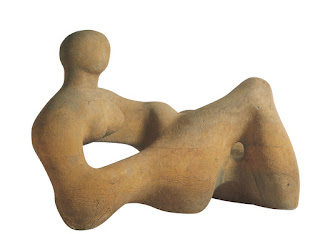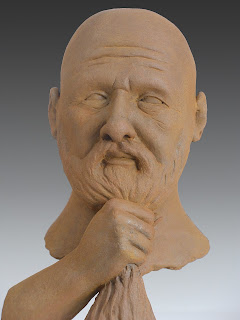In the art world there is often
talk of the desirability and necessity of a “consistent body of work.” This
simply means that the output of an individual artist, regardless of the medium,
be recognizable as the work of that specific artist. Thus, an art patron could
easily recognize this painting as the work of Piet Mondrian even if she had
never seen this particular piece.
I, personally, had never seen this sculpture before, but I immediately recognized it as the work of Henry Moore, the famous English sculptor.
These two examples highlight what is meant by a consistent body of work. Their style, color schemes, shape, form, degree of abstractionism, and additional elements are consistent with other works in the artist’s oeuvre.
Most artists create a body of work around subject matters, methods, styles, and further criteria about which they feel passion. In doing so, they give themselves the opportunity of exploring and experimenting with those artistic factors that most inspire them. They also gain the additional benefit of gaining greater technical proficiency in their chosen media.
Often students, novices, or emerging artists try on a variety of artistic
“hats” as they seek to find that which most speaks to them. However, after this
beginning phase, the majority of artists (and almost all professional artists)
settle in to creating a consistent body of work by which they are recognized.
But is this necessary? The preponderance of gallery owners would say “yes.” These gallerists spent a lot of time promoting the artists they represent and developing relationships with clients who are drawn to the work of individual artists. If the artist were to frequently change their style, the gallerist would have to repeat the process again and again at a cost of both time and money. Thus, most galleries see a consistent body of work as a necessary criterion to carrying the work of an individual artist. In fact, I’ve heard a few gallerists state that consistency and passion are even more important than creativity or skill in making sales.
While I fully believe in the concept of a consistent body of work, I personally find it hard to be constrained to any one style. As I began sculpting, I worked on small, table-top sculptures made of acid-stained cement with a rich textural surface such as “Burning Sun” and “Burnt Offering.”
"Burning Sun" from "Artifacts from a Former World"
These two pieces and others I
created definitely fit the criterion of a consistent body of work. However, as
time passed, I wanted to explore other styles, such as figurative work. I
considered my first works a separate series that I called “Artifacts from a
Former World,” and began work on a second series (or, if you will, a second
body of work), “Heads and Hands.”
To date I have begun work on five different
series of sculptures. Within each series of sculptures, the work is consistent
and recognizable as being from that specific series. However, the series
themselves vary from one to the other. Unlike most artists who move from one
series to the next, I find that I still continue to work on all my series. I
find interest and passion in each series and want to continue exploring the
allure that each holds for me. Thus, I am still working on the “Artifacts from
a Former World” series that I began over a decade ago.
This may not be a path that is taken by most artists, and probably not advised by most gallerists. However, for me it seems to be a path that fits my own passions, creativity, and need for variety while still adhering to the definition of a “consistent body of work.”
If you have any thoughts on the subject, I would love to hear from you.
In my next blog posting I will talk about a sixth series I have recently begun. This series, “It’s About Time,” is based not on the general consensus of what constitutes a body of work but is, instead, based on a unifying theme that overlies all of the sculptures within the series. The theme of time.







No comments:
Post a Comment